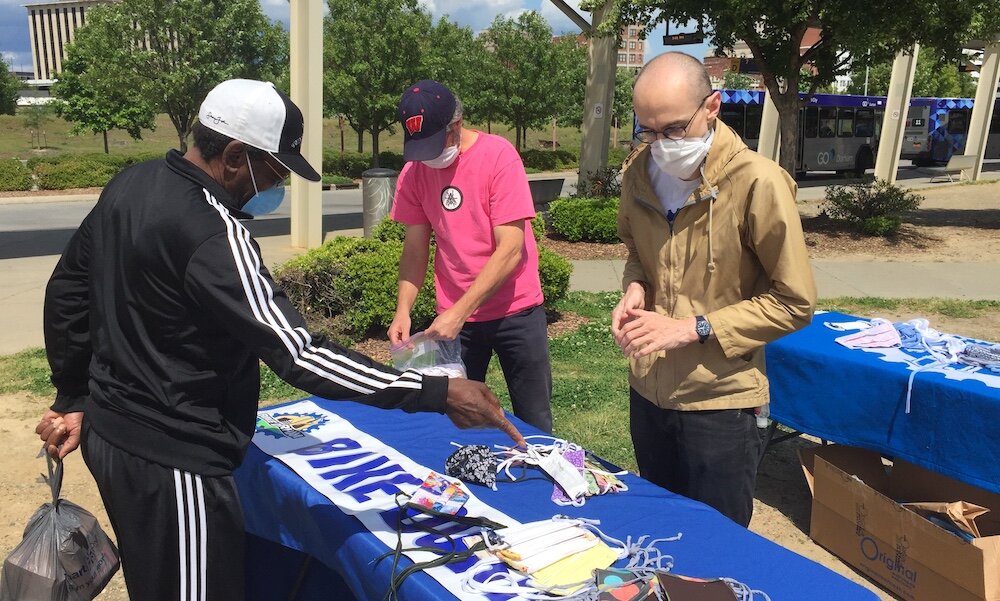Transit Equity Campaign
Mission Statement
Durham has a transportation system created through a history of decisions that have led to inequitable outcomes along racial and economic lines. To promote anti-racism and equitable outcomes, the Transit Equity Campaign will hold the public agencies in charge of updating the Durham County Transit Plan accountable to make sure the needs of current transit riders, transit workers and low-wealth BIPOC (Black, Indigenous, and People of Color) communities are the first priorities in the Transit Plan.
Transit Equity Campaign Releases Position Paper
The demise of the light rail project in 2019 was a big blow to Durham and the region, but it also presented an opportunity to center racial equity in an update to the Durham Transit Plan. Achieving racial equity requires a new approach, one that places the needs of transit riders, transit workers, and communities of color first and gives decision-making power to those who have suffered the greatest harms from Durham's transportation system.
One thing that has become clear during the Durham Transit Plan update is that there is not enough money to do everything on the transit wish-list. Until additional resources are identified, choices will have to be made about how to spend what is available. Current riders, transit workers and Black and Brown residents in Durham have made their priorities clear:
Sidewalks and safe connections to bus stops
Benches, shelters, and better lighting at bus stops
More frequent, reliable, and fast local and regional service connecting Black and Brown communities to jobs, education, shopping, healthcare, and recreation
Salary and benefit increases for frontline transit workers
A continuation of fare-free service
Electric buses, solar-powered lighting at shelters and other elements that mitigate any negative environmental effects
Only once all of these needs have been met should higher cost and more time-consuming capital projects be considered. If these capital projects can be afforded, they must still meet the needs of Black and Brown residents in Durham and several safeguards must be put in place to ensure that they remain financially feasible, meet the guidelines of key stakeholders and do not cause additional delay to near-term improvements.
You can read the full position paper with more detail about the projects and information that the Transit Equity Campaign believes must be included in the forthcoming Recommended Durham Transit Plan that will meet the needs we heard from current transit riders, transit workers, and communities of color in Durham.
This position paper has been signed by the Durham Committee on the Affairs of Black People, Durham Congregations in Action, and Bike Durham thus far. We expect other organizations will sign on in the coming weeks. If your organization would like to sign onto the Transit Equity Campaign position paper, please contact Erik Landfried at transit@bikedurham.org.
Will the Durham Transit Plan Prioritize Improvements for Current Riders?
Durham County, the regional transportation planning organization (DCHC MPO), and GoTriangle released three options for how to invest one billion dollars in transit tax revenues over the next twenty years. All options contained some common projects and service improvements using half the money. They differed in how to spend the remaining one-half billion dollars. One option prioritized improvements in local service and sidewalks, while including additional regional bus service. A second option prioritized investments in regional Bus Rapid Transit to Raleigh and to Chapel Hill. The third option prioritized investment in commuter rail to Raleigh. Both the Bus Rapid Transit option and the Commuter Rail option included local bus service and sidewalk improvements but there are fewer of them and they occur up to 7 to 10 years later. During the period when the Durham Transit Team was collecting public input, the Transit Equity Campaign was talking to riders about their priorities.
Erik Landfried, Bike Durham board member and manager of the Transit Equity Campaign, wrote a letter on September 9 to the staff and elected officials working on the plan to share what we heard from riders and to make recommendations for evaluating the options and developing a better final plan.
Click Here to read the letter and learn more
Challenges to Equitable Transit - A Durham Documentary
In “Challenges to Equitable Transit - A Durham Documentary”, we see and hear the voices of transit riders and transit workers as they describe the main challenges they face using the bus in Durham. These challenges echo ones we’ve heard from other riders, transit workers, and people who live in low-wealth communities of color and that were captured in the first round of public engagement for the Durham Transit Plan update.
Riders are demanding:
More frequent service
More reliable service
More direct service with shorter travel times to jobs and other destinations in Durham and the region
Safer walks to bus stops
Accessible and comfortable bus stops
Expanded paratransit and other curb-to-curb service
Read the full story and watch more videos on our latest blog post HERE
Press Release
On September 1, 2020, Bike Durham, the Coalition for Affordable Housing and Transit, the Durham Committee on the Affairs of Black People, Durham Congregations in Action, and the People’s Alliance launched the Transit Equity Campaign. The following press release lays out the campaign’s vision and the urgency of its mission.
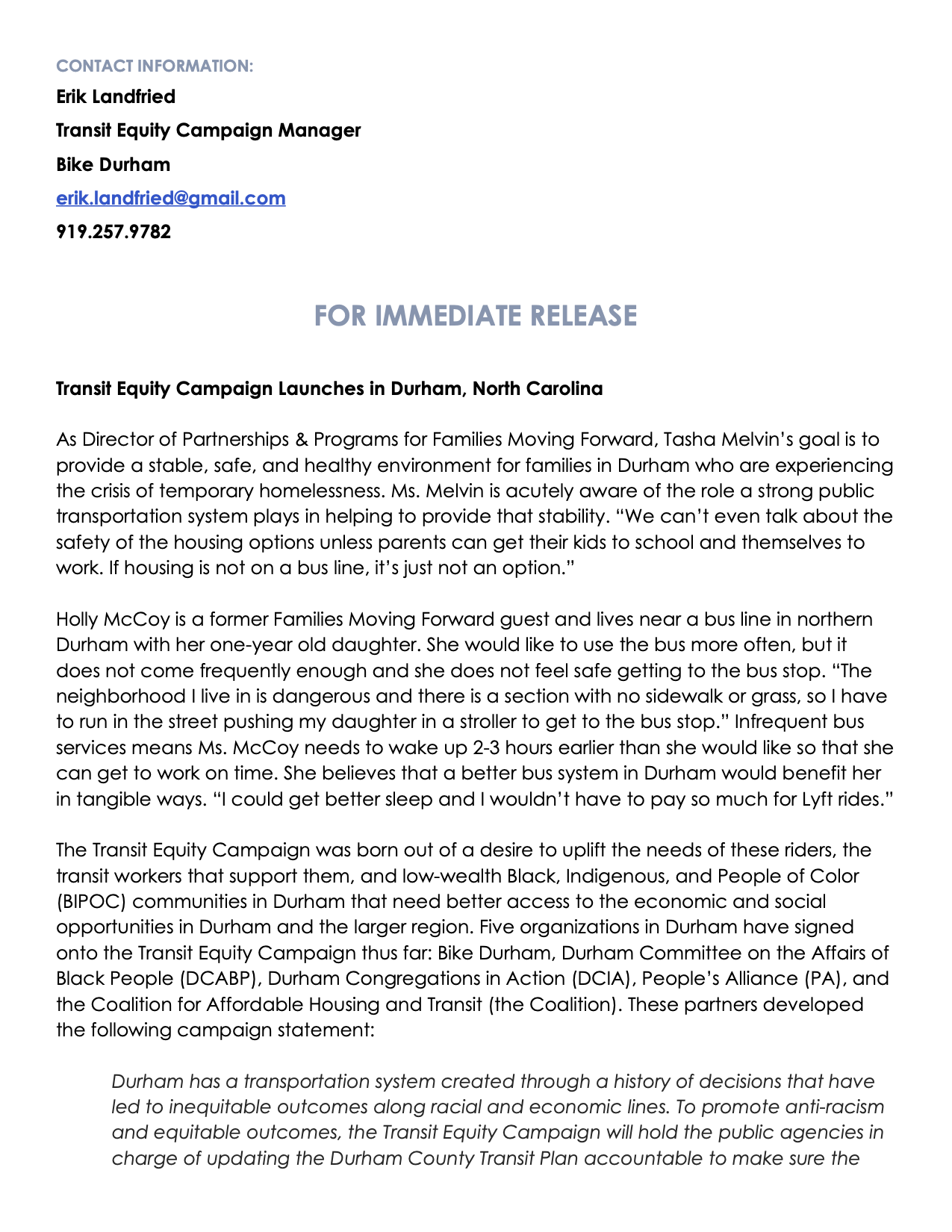
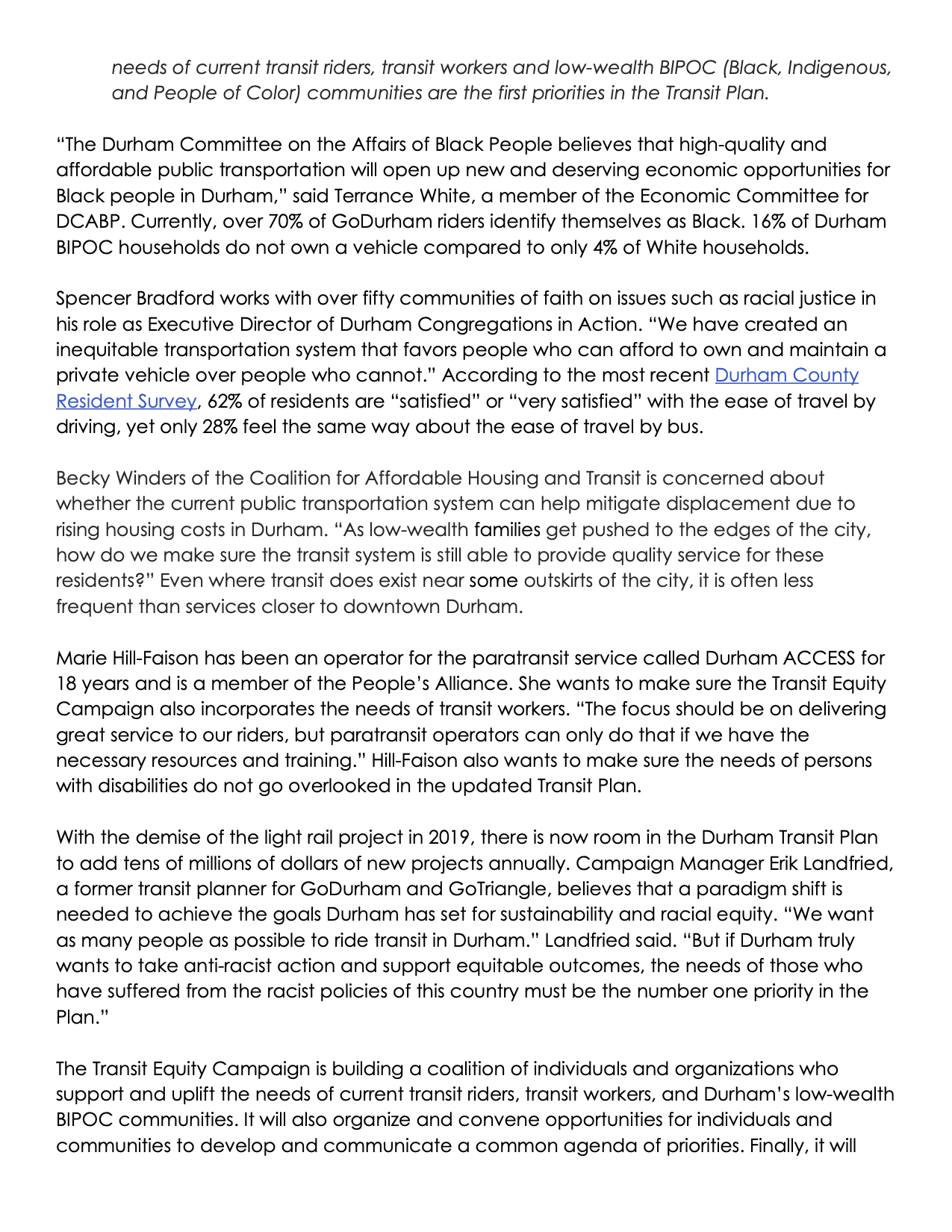


Transit Equity Campaign Description and Strategy
The needs of low-wealth BIPOC (Black, Indigenous, and People of Color) communities have been largely left out of transportation planning decision-making in the United States. As a result, we have created an inequitable transportation system that favors people who can afford to own and maintain a private vehicle (mostly white, wealthy citizens) over people who cannot. This is no different in Durham. Recent data reveal that 16.1% of Durham BIPOC households do not own a vehicle, while only 4% of white households do not own a vehicle. According to the most recent Durham County Resident Survey, 62% of residents are “satisfied” or “very satisfied” with the ease of travel by driving, yet only 28% feel the same way about the ease of travel by bus.
If Durham wants to promote anti-racism and equitable outcomes for its residents, a new approach to transportation planning is needed that centers the needs of communities that have traditionally been left out of the process. The update to the Durham County Transit Plan offers one opportunity to do just that. In supporting a half-cent sales tax for transit, voters have shown that there is broad support for a high-quality public transit system in the City and the region. With the demise of the light rail project in 2019, there is now room in the Transit Plan to add tens of millions of dollars of new projects annually. Where, and for whom, should those millions of dollars be invested?
We want as many people as possible to ride transit in Durham, but if Durham truly wants to take anti-racist action and support equitable outcomes, the needs of those who have suffered from the racist policies of this country must be the number one priority in the Plan. Only 14% of GoDurham riders identify as Caucasian/White and 53% report a household income of less than $15,000 per year. We recommend that the organizations leading the Transit Plan update base their approach on the Mobility Equity Framework developed by the Greenlining Institute. This framework recommends three key steps:
A higher quality transit system will have extensive benefits for Durham residents:
Better connections to jobs, education, and services
Safer and healthier ways to get around, with fewer injuries and deaths
More accessibility for residents without access to cars and persons with disabilities
Improved environmental sustainability
Our Strategy
Our strategy for building power to influence the priorities of the Durham County Transit Plan is as follows:
Build a coalition of organizations who support prioritizing the needs of current transit riders and employees, and in particular Durham’s low-wealth BIPOC communities
Organize transit riders who will be directly affected by changes to the transit system to participate in the Transit Plan public engagement process
Convene opportunities for transit riders, transit workers, low-wealth BIPOC communities, and other advocates to communicate transportation needs and to develop a common agenda of priorities
Evaluate investment scenarios brought forward by the public-sector Durham Transit Team
Hold decision-makers accountable through petitions, media stories, and direct communication with elected officials
Build a Coalition
Five Durham organizations - Bike Durham, Durham Committee on the Affairs of Black People, People’s Alliance, Durham Congregations in Action, and Coalition for Affordable Housing and Transit - are the initial signees on the Transit Equity Campaign. We continue to reach out to other organizations that advocate for racial and economic equity in Durham to build the coalition.
Organize Transit Riders
Bike Durham has distributed 8,000+ face coverings at Durham Station since mid-April, and have begun to use that opportunity to invite individuals to share their contact information if they are interested in updates from about the Transit Equity Campaign. We have also spoken to current riders that other organizations have put us in touch with. The Campaign will continue to use similar opportunities to recruit transit riders.
Convene Transit Riders and Advocates
Campaign partners will host and participate in multiple events (in-person and on-line) to develop a specific set of transit needs and projects for the Transit Partners to incorporate in their investment scenarios, and then to develop positions on the draft plan.
Evaluate Investment Scenarios
Campaign partners will evaluate the proposed investment scenarios as they are developed by the Durham Transit Team against criteria for mobility, economic development, and environmental sustainability, with scrutiny of who would benefit and who would bear the burdens of each scenario.
Hold Decision-Makers Accountable
We will organize participation in the official public engagement processes as well as organizing petitions, email campaigns, and media events to demonstrate the strength of support for coalition positions. The targets include officials at the City, County, MPO, and GoTriangle.
Campaign Partners
Bike Durham believes everyone should have access to safe, affordable, and sustainable transportation regardless of race, wealth, gender identity, ability, or where they live. Bike Durham empowers people of all ages to walk, bike, and ride transit more often by promoting policy, infrastructure, education, and community events.
The Coalition for Affordable Housing and Transit is a community-wide volunteer organization that works (1) to understand the complex challenges of affordable shelter and transit and (2) to increase the supply of both by advocacy for better public policy and by working with other public and private partners on specific projects.
The Durham Committee on the Affairs of Black People was founded in 1935 as an organization to work toward the elimination of racial discrimination or distinction in public and general private affairs. It continues to be a leadership body for the Black residents of Durham.
Durham Congregations in Action (DCIA) organizes communities of diverse faiths to work for racial justice, social equity, and human dignity. They lead inter-faith learning and cooperation to overcome poverty, racism and violence.
Since 1976, People's Alliance members have worked together -- across race and class -- toward establishing Durham as a progressive model for the state and country on issues including school integration, the environment, living wages, and affordable housing. PA is a participatory, democratic organization that uses a collective voice to demand a just, equitable and more inclusive Durham and hold public officials accountable to those values.
Get Involved
To sign onto the Transit Equity Campaign, click one of the buttons below. If you would like to volunteer to help with the campaign or if you have questions about it, please contact Campaign Manager Erik Landfried at erik.landfried@gmail.com.
Resources
The current Durham County Transit Plan
The Greenlining Institute’s Mobility Equity Framework
An example of how the an equity strategy has been used at MUNI in San Francisco
How a coalition organization engaged in transit advocacy in New Orleans
FAQ
Frequently Asked Questions — to come.
Bike Durham Meets with Champions4Change
On June 20th, Bike Durham was invited to a conversation with members of Champions4Change, a group of staff and guests of Families Moving Forward, an organization that helps families in the crisis of homelessness find their way home. Our goal was simply to listen to the challenges and opportunities these families face in moving about Durham to access critical resources and to uplift their voices as best we could. We appreciate how generous the women that we spoke with were with their time.
We have tried to summarize what we heard as best we could, but fully recognize that biases can come through when trying to identify larger themes. We encourage you to read the full set of notes at the bottom of this post.
The biggest point that came across in the conversation is that transit is essential for these women to access jobs, schools, and services in Durham and the larger region. Staff at Families Moving Forward make sure housing for each family they work with is on a bus route before checking to ensure that the housing conditions and location are safe. That’s how critical good transit access is for their guests - if it doesn’t exist, they won’t even consider it. It was noted that there is affordable housing in neighborhoods with good bus service, but those neighborhoods were considered by the women to be “bad” neighborhoods. On the flip side, there is some affordable housing available at the outskirts of Durham, but bus service there is often poor or non-existent. These two factors greatly limit the options these families have to find stable housing in Durham.
The need to improve the quality of service provided was also mentioned often. The Champions4Change group said that buses need to be more direct, including crosstown service with multiple hubs to allow for transfers, and service needs to be every 15 minutes or better. One mother said that a job that was five minutes away by car would have taken her two hours by bus. They also mentioned that having good regional service is also important to access good jobs in neighboring towns. Unfortunately, a few women told stories of being passed up by bus operators while waiting at bus stops and bus routes ending in dangerous locations, which hinder their ability to rely on the system.
Access and safety both at the bus stops and getting to/from the bus stops and other destinations was also brought up several times throughout the conversation. All of the women we talked with are mothers and many mentioned the challenge of using strollers in Durham to access the bus. The lack of sidewalks in northern Durham where most of them live is a major barrier to getting to bus stops and walking to jobs and services such as grocery stores. Many relayed stories of people being hit by drivers along roads without safe pedestrian accommodations. They also mentioned how difficult it is to cross major roads in Durham and the poor lighting along the streets. Once they get to the bus stops, the stops themselves are often not accessible and more need to have shelters and benches.
Listening to the women in the Champions4Change group describe the challenges they face to safely move about Durham and the clear connection they made between having access to safe transportation options and access to good jobs, schools, and services was eye-opening. Bike Durham believes that the public agencies in charge of updating the Durham Transit Plan need to set up similar conversations to listen to the needs of those who rely on transit, walking, and biking every day and give those people a direct say in what is incorporated into the updated Transit Plan.
We would also encourage everyone to read the full set of notes from the meeting—we surely missed some things that were said, but did our best to try to write down the language these women used as much as possible.
Connection between access to transit and access to safe housing, jobs, education, and other services:
One FMF guest (not present) told staff that transit was her only way to get to jobs.
A bus has to go past her home, job, and kids school (Oak Grove doesn't have service).
Staff member: For Families Moving Forward, have case managers to help connect families to housing. Will say "Can't even talk about safety unless you can get your kids to school and you can get to work."
A lot of unsafe housing, but has good bus service.
Chose a sub-optimal daycare because it's the only one where she could pick up/drop off their kid.
"No way I could live downtown, but that's what's close to the station."
FMF staff looks for a place on a bus line (if not, that housing is not an option). Having access to transit is looked at BEFORE safety of the housing itself.
Housing is cheaper in northern Durham, but not as many buses up there.
Hard to find affordable housing in Durham. Lived on Duke St, but no bus lines on it.
"If you go somewhere cheap, you have to live in a bad neighborhood."
Good service in bad neighborhoods.
"In RTP, Definitely need a vehicle."
There are good jobs in Cary, Raleigh, CH, but they are hard to reach.
Lots of jobs in manufacturing (A&W, Cree, PBM Graphics, etc.), but poor bus service.
Service quality is very important:
Need bus service on every major road every 15 minutes.
Once had a job within 5 minutes drive, but would have taken 2 hours via bus.
Got passed up by a bus driver and had to walk to the bus terminal.
Has lived in other cities where you don't have to have a car. Takes too long to get to other cities in the Triangle.
Would be great to ride a train.
Buses end too early - can't do a 3rd shift job.
Why does every route go downtown? Easier to change at a major intersection. Why isn't there more than one terminal?
More frequency solves problem of trying to catch a bus or buses running early or late.
Bus drivers will pull over for 5-10 minutes even when you're running late.
Many use TransLoc to track buses. App jumps from 2 minutes to 8 minutes, doesn't always seem to work.
Had three options once (BCC, other GoDurham route, and Duke Transit) when living at Duke Manor. Moved to Morreene Road - only Route 6 and if missed it, wait for 30 minutes. Took too long to get to East Campus!
Staff member: Started taking Uber/Lyft more.
BCC service ended early and dropped people off without getting back to the terminal - no lights and was scared. Buses and operators should announce when service is ending for the buses.
Was more expensive to buy a transit pass in Atlanta, but it was worth it because she could get everywhere she needed to go.
"If the service was better, would be worth paying for it."
"Should be a single pass for everything."
Some routes to high schools end too early.
A/B routings are confusing.
Most places take about 30 minutes to get to. Need that to be shorter.
Durham should treat transit as a metropolitan area.
In Atlanta, lived in Stone Mountain, but could get downtown easier than she can here. If she gets a good job, will take Uber/Lyft.
Walking to bus stops and other destinations and waiting for a bus can be unsafe or uncomfortable:
Hard to catch the bus with kids - no sidewalks for strollers. Bus stops are too far away for a parent with kids.
When it's raining, not many bus stops have places to sit or shelters.
Hard to push strollers w/no sidewalks and have to break down stroller on the bus, which is hard to do.
Used to live at Oxford Manor, work was down Danube (Brookdale), but there was no sidewalk. Bus took too long.
Her teenage boys ride bikes, but most people have to walk in the street.
Once lived on Morreene Rd. Was a nice area to walk around, but no sidewalks. Narrow road.
City built a roundabout, but didn't connect the sidewalk to Oxford Manor!
Drove down Riddle Road - guy was walking on the road and she just missed him. Found out he was killed later that night.
Another person on Danube and Denfield noticed people walking in the street because there is no sidewalk and poor lighting.
On Horton Rd (behind Food Lion), there is a hill behind the bus stop and she has to push a stroller on the grass.
On a major road, it's really hard to cross that road, so sometimes people get on a bus going the wrong direction just to avoid crossing the street. Specifically Erwin Road.
In Durham, you have to risk crossing the street.
Fayetteville Street is also tough because at night it was too dark. Better lighting at bus stops would be great.
North Roxboro has no sidewalks - friend slipped into the road, was almost hit by a car.
No streetlights, no sidewalks - need more of both throughout Durham.
Other challenges presented by the current transportation system in Durham:
One guest needed to take DATA to Durham Tech, but sometimes didn't have $2 to buy a pass.
Doesn't feel comfortable in large groups, which makes taking the bus hard for her.
One former guest does use a car to get to a job in Cary, but has had to get rides if her car breaks down.
Question about whether ACCESS vans could be used by more people.
Need to bring more bus lines out to Danube.
Route 9 used to run down Horton - now has to catch Route 1 on Guess Rd.
Providing Face Coverings at Durham Station
With coronavirus spreading in our community, it’s vitally important for transit riders in particular, who share an enclosed space for prolonged periods, to have access to protective face coverings that will help slow transmission. In partnership with Covering the Triangle and NC Face Mask Warriors, Bike Durham has made several trips to Durham’s main bus station to hand out face coverings to all who need them. So far, we have distributed around 4,000 coverings. Most were given to bus riders, but a few operators and GoDurham staff also stopped by for these well-made, life-saving articles of “personal protective equipment.”
Bike Durham director John Tallmadge (center) and member Nick Doty (right) distribute masks.
Bike Durham Supports Transit Workers and Riders
This IS Our Mission
Bike Durham believes everyone should have access to safe, affordable, and sustainable transportation regardless of race, wealth, gender identity, ability, or where they live. During this time of the COVID-19 pandemic, our mission has led us to raise awareness that essential workers rely on our public transit system, and many of our most vulnerable residents continue to rely on GoDurham during the stay-at-home order in order to get to essential services. We have lifted up the stories of transit and paratransit operators who continue to drive the buses and vans of this essential service. We are continuing to partner with other local organizations in working with the City, GoDurham, and GoTriangle to ensure that our most vulnerable people can stay safe while riding GoDurham and ACCESS, and can reliably get to work and essential services without long waits. Our work is also connected to a national movement to draw attention to these issues and get more federal support.
Many Durham Residents Still Rely on GoDurham and ACCESS Services
Despite a recent 40% decrease in ridership on GoDurham due to the COVID-19 crisis, many people in Durham still rely on the system to make essential trips for work, groceries, and medical care. The majority (73%) of these riders are black and 53% report a household income of less than $15,000 per year. More resources are needed to ensure that the bus and paratransit employees and riders are protected from the virus, and that Durham’s most vulnerable citizens are not additionally burdened in their essential travel.
Riders are being informed at Durham Station that the number of people allowed on the bus will be limited. Bike Durham supports the decision to limit the number of riders on board each GoDurham bus to maintain recommended physical distancing. However, this policy means that riders are being passed up at bus stops and are having to wait long periods of time to board the next bus if the one they are trying to board is full.
DeArman S. told Bike Durham’s executive director, John Tallmadge, that she has had to wait a full hour to get to and from her home in south Durham to her job at a McDonald’s on Horton Road in north Durham due to full buses on Routes 5 and 9. Brandon W. also has had to wait 30 minutes for the next Route 12 bus when going to and from his job at a Waffle House on Highway 55.
We Can Have Safety AND Mobility
GoDurham recently announced that they are increasing the limit on the number of people who can board a bus from 10 to 16. It is encouraging to see the City taking seriously the issues we’ve raised about customers missing buses leading to long waits, but this raises new questions about whether this allows for recommended physical distancing on the bus. It also does not fully solve the capacity issues.
According to data obtained from GoTriangle for a time period covering March 29–April 11, 2020, there were more than 16 riders on a GoDurham bus on 10% of weekday trips, 7% of Saturday trips, and 13% of Sunday trips. On Route 3, the busiest route in the system, 56% of weekday trips carried more than 16 riders at any given time.
Riders who cannot board a bus because it has reached the capacity limit are faced with a difficult set of choices. They will either need to wait up to an hour for the next bus, which may also be full, or find another way to get to their destination. These alternatives likely include a combination of shared rides, walking or biking along roads that may or may not be safe, or simply not making the trip at all. This type of uncertainty is an unwanted added stress at a time when many are already risking their own health to make essential trips.
Bike Durham Requests Further City Action
Bike Durham has requested that the City and GoTriangle address the following urgent issues immediately:
Provide face masks free of charge to all customers and operators who need them until the need for them ends. Bike Durham has distributed more than 2,000 masks at Durham Station thanks to Covering the Triangle, but more are needed now and until this pandemic has passed.
Develop strategies to ensure that Durham’s most vulnerable residents are still able to travel to essential jobs or services without extra delays or unreliability due to the new capacity limits. This may require partnerships with other transit agencies to provide more bus service on crowded routes.
Ensure that safe alternatives to riding the bus are provided to facilitate physical distancing, such as temporary walking paths using underutilized road capacity, or partnerships with e-scooter companies currently operating in Durham. This is important now, and will be critical when the stay-at-home order begins to be lifted and more people who rely on GoDurham and ACCESS paratransit will need to travel again.
For more information about Bike Durham’s request to the City and GoTriangle, please see our letter to Sean Egan (below), Transportation Director for the City of Durham.
We Want to Work With the City and GoTriangle to Address These Issues
Bike Durham understands that this is a challenging time to make additional requests of the City and GoTriangle, and we would not do so if we did not believe this is an urgent matter. Our organization has volunteers and board members who are ready to assist the City and GoTriangle to help identify and promote solutions to these issues.
Bike Durham Letter to Sean Egan, April 23, 2020
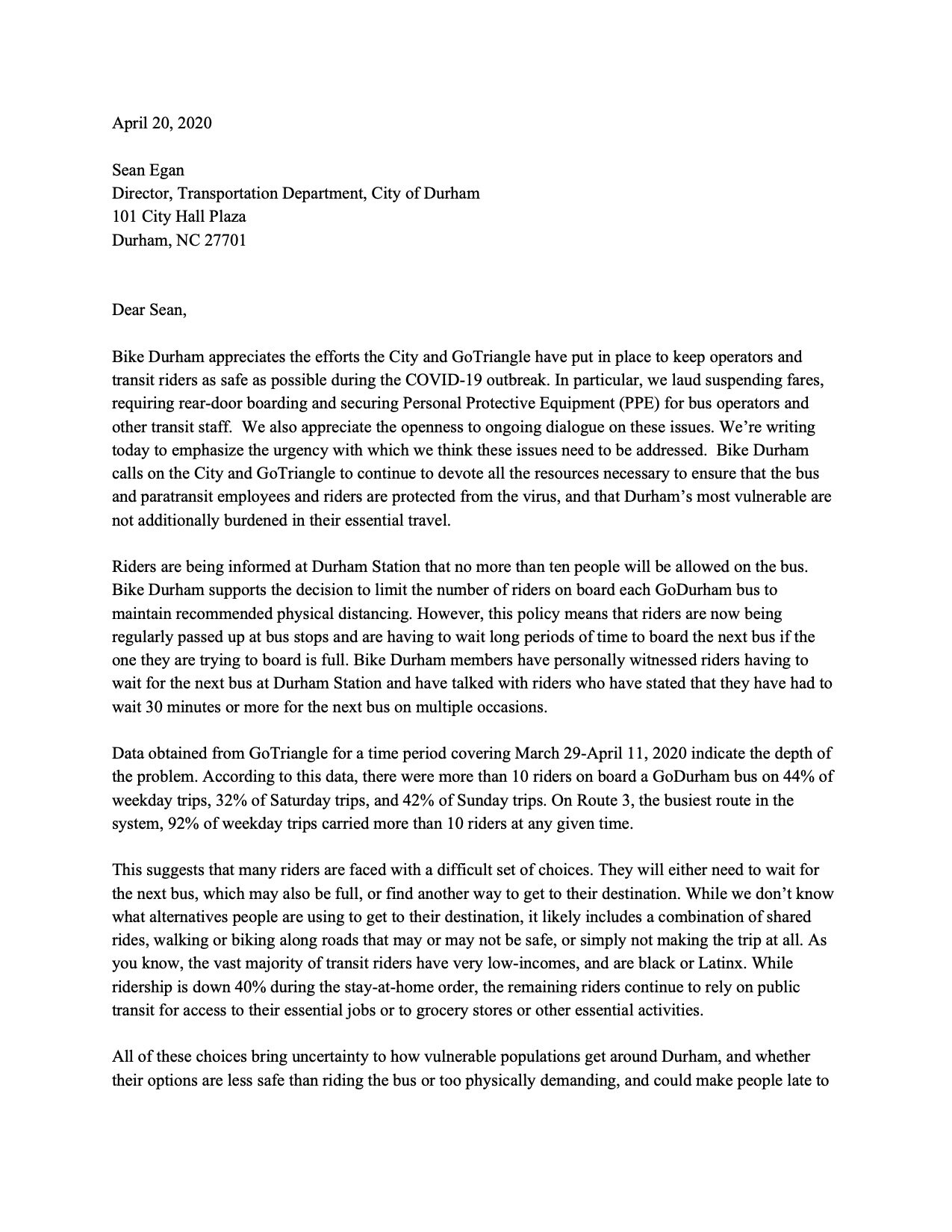
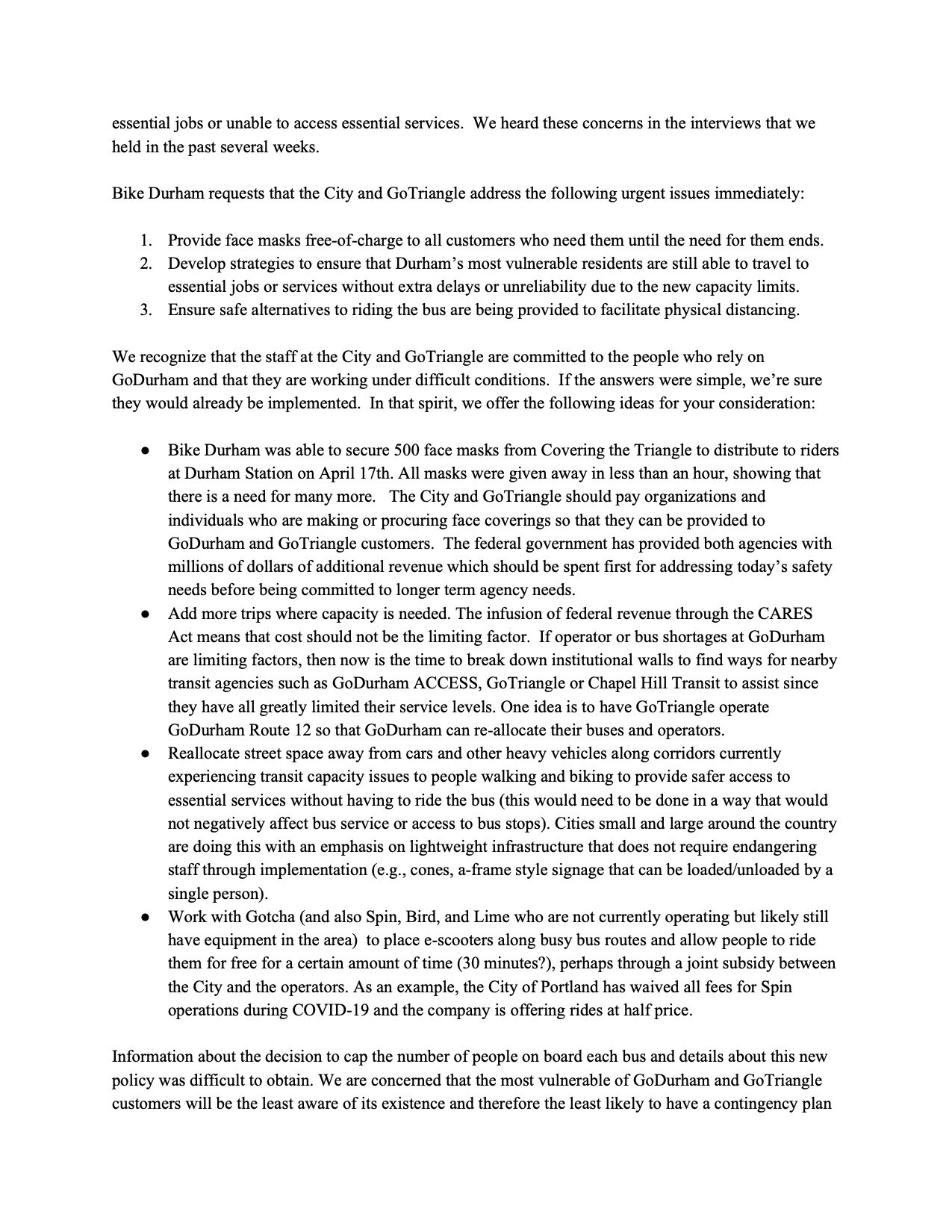
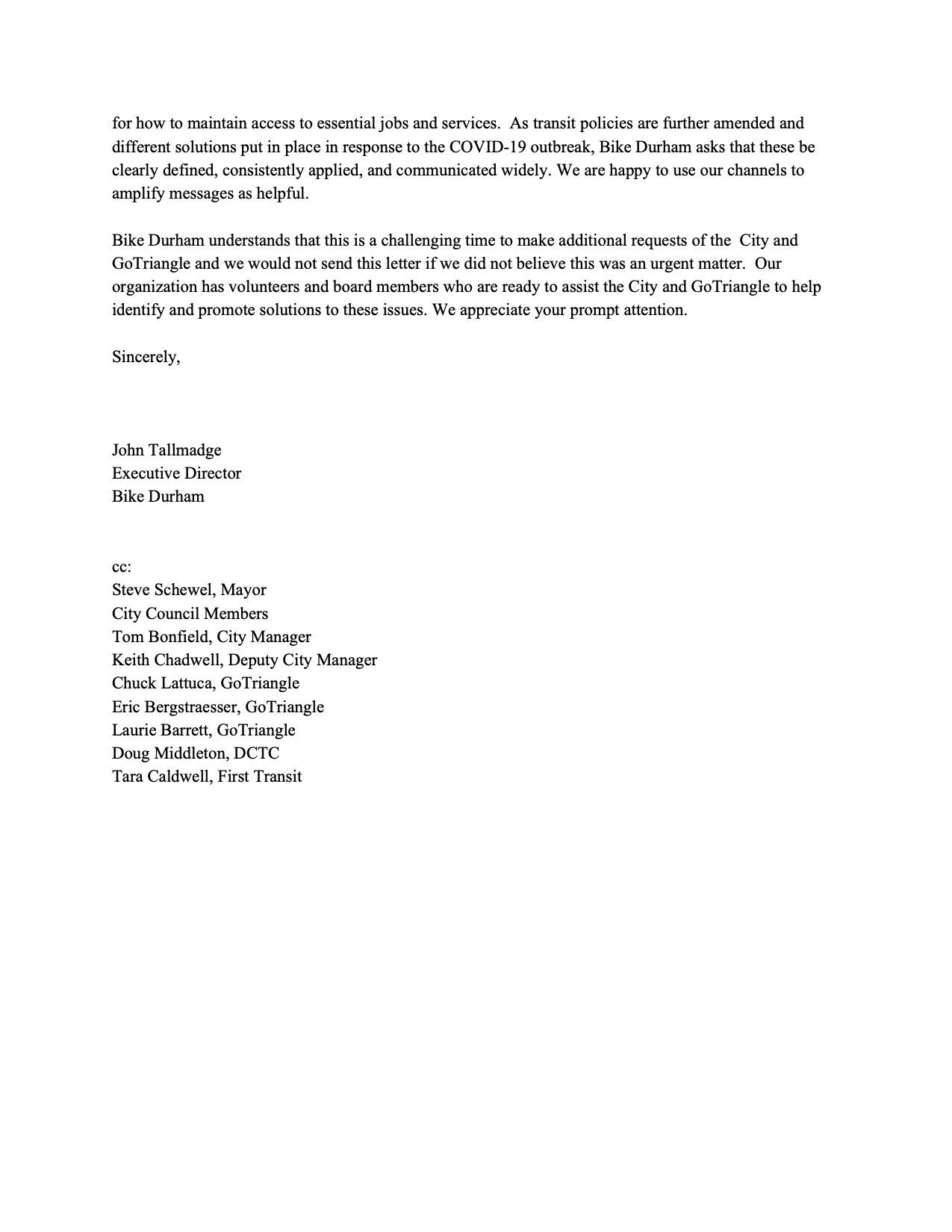
Bike Durham Supports Transit Operators
In these challenging times, some cities have suspended bus service. Durham has kept the buses running, which has provided crucial support to some of the city’s more disadvantaged communities. It’s also moved bus operators to the front lines of the battle to preserve the normal workings of the economy, while placing their personal safety at no small risk.
Bus ridership is down, and service and hours of operation have been cut back. While many customers are able to stay home or have found other ways of getting around, bus and paratransit van operators continue to work their shifts serving the remaining customers.
To protect bus operators and keep customers properly distanced, the City and GoTriangle have instituted fare-free, rear-door boarding. Some seats are marked unavailable, and operators can activate a "Bus Full" sign once 14 people are on the bus. The City of Durham is paying for operators of GoDurham buses and ACCESS vans to receive a 5% wage premium during the Stay-at-Home order.
Bike Durham appreciates the GoDurham operators and staff who are keeping the buses running during this time of crisis. #TransitIsEssential
As discussed below, Durham’s decision to keep the buses running during this time of “flattening the curve” has been crucial to the people who rely on it to get around. Mayor Steve Schewel’s “Stay at Home” order allows for “essential” services to continue operation; along with hospitals, this includes bicycle shops, grocery stores, restaurants, construction sites, utilities, and other places of work.
Bike Durham Supports Transit
On March 23rd, GoDurham began offering fare-free, rear-boarding service to protect the safety of bus operators. Transportation Director Sean Egan says “GoDurham intends to provide service for essential trips in our community for as long as it is safe and appropriate to do so.” Bike Durham applauds this decision. #TransitIsEssential
On March 23rd, GoDurham began offering fare-free, rear-boarding service to protect the safety of bus operators. Transportation Director Sean Egan says “GoDurham intends to provide service for essential trips in our community for as long as it is safe and appropriate to do so.” Bike Durham applauds this decision. #TransitIsEssential
Durham Residents Continue To Rely On GoDurham During Pandemic
After Durham Station, the second busiest bus stop in Durham is in east Durham at the Village Shopping Center, sometimes called Wellons Village, near the intersection of North Miami Blvd and Holloway Street. There is always a crowd, of varying sizes, getting ready to get on a bus headed downtown, out toward Walmart on East Geer Street, toward the Holton Career and Resource Center on Driver Street, or east down Highway 98.
This Tuesday at mid-day, the scene was no different. As the time neared for buses to arrive, people would gather on either side of Raynor Street, ready to get on. Some were clearly concerned about the COVID-19 virus, keeping their distance from one another, or wearing masks and gloves. Talib W., an older man from east Durham was wearing a worn light-blue face mask and winter gloves. He said since the virus, “it’s changed a lot. There are less people, it’s not as crowded as it used to be. You see more people are using protective gear. Masks and gloves. Not all of them, but you’ve got those who are conscientious.”
Others were less concerned, joking with one another, or sitting right next to each other under the lone shelter at this busy location. A young man sitting under the shelter said he’s not worried about being too close to others on the bus. “I think people are taking this virus too seriously.” The young woman with a toddler in her lap said people need to get to work to make money. She said when you have to choose between making money and risking getting sick, people are going to do what they have to to make money.
Earl C. Photo by John Tallmadge
Others shared their stories about how critical GoDurham was for them. Earl C., a middle-aged man from east Durham, said “If the buses shut down, it would affect me in my responsibilities in going to see my kids, probably to go to work, everyday travel.” He’d continued, ”Education, health, doctor’s appointments, picking up medications, the post office. It would affect a lot for my everyday travel, everyday use. It would be very detrimental to my everyday life.”
Mr. Glenwood J, who lives near Northgate Mall shared, “I use GoDurham almost exclusively. To pick up personal items, to get groceries, especially to get to Durham Tech’s campus to take classes. It’s a critical part of my daily life.”
Ridership is Noticeably Lower
All the people waiting at the Village had noticed that there were fewer people on most buses. That’s confirmed by data from staff at GoTriangle who shared that on Monday, ridership on GoDurham was down about 25% from a normal Monday, and that ridership on GoTriangle was down 60-70%. These figures are in line with results from other transit agencies around the country, where commuter-oriented services have seen precipitous declines in riders who are now working from home or have been laid off. Local transit services, whose customers use the services for work and education, but also for connections to grocery stores, medical appointments, and other services, have seen lower declines in usage.
Here in Durham, it can vary by route. Talib W “was surprised that I got on one bus, and there was nobody but me when normally these buses on Route 3C have 20 or more people on them. But for those who have to go shopping, they can’t help but get on a crowded bus, but [many] still have the protective gear.” According to GoTriangle planners, Route 3, which goes to Walmart, only had 12% fewer riders than a normal weekday. Mr. Johnson said “I just came down on Route 3 and it was probably three-quarters, almost full capacity.”
Earl C. observed that many buses are less crowded because lots of things are shutting down. “I went to Social Security today. Social Security office is shutting down. I tried to get some clothes at CitiTrends [a clothing store] and it was shut down. A few other places where I tried to go do some things were shut down. And the buses are shutting down [early at 9:30pm].” He was concerned about whether GoDurham service would continue to operate. “I don’t know if thery’e going to have the buses too long, because everything is shutting down. And there’s less people on the bus and they don’t really want to be together with each other, so I don’t really know how long that will hold up.”
GoDurham Connects Some Riders Who Donate Life-Giving Plasma
Glenwood J. Photo by John Tallmadge
Transit Is Essential Connection to Healthcare Jobs
Standing away from the others at the bus shelter in front of the Duke Medical Center, Jani Hale waits for her GoDurham bus. Wearing her light blue surgical gloves, she’s ready to take the bus home at the end of day working for Duke University Medical Center’s Department of Psychiatry and Behavioral Health. She rides every day and has noticed that it is a lot emptier on the buses since the COVID-19 pandemic took hold in Durham. She has continued to ride because it’s her only way to work, and she appreciates that there is hand sanitizer on-board and that the city of Durham has recently made the buses free of charge. “It kinda lessens the heavy weight that we’re all carrying right now.”
Adjacent to the bus stop is a CSL Plasma donation center. CSL Plasma is one of the nation’s leading producers of blood products. According to their website, “Plasma is the essential ingredient for products crucial to treating patients suffering from a host of life-threatening conditions and bleeding disorders.” At companies like this, donors are compensated for their donation. Again, according to their website, new donors can earn up to $400 in their first month. Continuing donors can earn about $300 if they make donations twice each week. Earl C. said sheepishly, “I go sometimes [to earn money] to pay bills, get groceries, pay fines. City fines for traffic tickets or things of that nature. It’s pretty beneficial to have that open. I was surprised it’s open because of the COVID virus. I don’t know how long that’s going to be open.”
As long as it remains open, and GoDurham remains operating, Earl C. and Glenwood J. will continue to ride here to donate plasma so that they have the money to pay their bills and get groceries. It’s an important source of income for them. This is the underlying message in all of these stories - GoDurham is essential in connecting them to ways to earn money and to all of life’s necessities. While some are nervous about exposure to the virus, nearly all are more concerned about what it would mean for GoDurham to stop running.
Jani Hale, Duke University Medical Center Employee, waits on GoDurham Route 20. Photo by John Tallmadge
On Sunday night, the City of Durham, followed by GoTriangle, the City of Raleigh, and the Town of Cary, suspended fares and required boarding through the rear doors in response to the COVID-19 pandemic. As reported Monday in the Raleigh News & Observer, Sean Egan, transportation director for the City of Durham said these measures are intended to keep customers and employees safe. “GoDurham operators and all of our front-line colleagues face the same pressures as everyone else right now,” Egan said in a written statement.
“They have families, kids out of school, loved ones with health concerns, and others may know someone already impacted by COVID-19. Despite these pressures, and despite understandable concerns, our workforce is showing up out of a sense of duty to the community.”
Egan said GoDurham will continue to operates as long as it is “safe and appropriate to do so.” Durham Mayor Steve Schewel shared in an email that he’s “worried about the social distancing on buses.” He is discussing with partners whether to run extra buses on busy routes “so we can cut down on the number of people on each bus. I’m not sure this is going to be able to happen, but I think it would be good if we could do it.”
Jen an Occupational Therapist at Duke Hospital who lives about two miles from the hospital on Route 11B, remarked that “everybody seems to be adhering to the precautions about being six feet apart. I just try to be careful and carry hand sanitizer with me and not touch anything.”
If the local bus systems or GoTriangle stopped running their services, or significantly cut back on their frequency, most remaining passengers would have few, if any, remaining options. While Jen has a car, she does not pay for a parking space at Duke Medical Center, so if the buses stopped running, she believes that “she would be in a bit of trouble.” Jen thinks she “might have to ask friends for a ride, which would be very inconvenient and scary for them. They don’t want to be close to others right now when we’re supposed to be socially distancing. I think that the bus is probably a better way to socially distance oneself than carpooling.”
Masti, a young woman who works in a lab at Duke University Medical Center, rides GoTriangle route 405 and connects to Chapel Hill Transit routes. She has already had to adjust to last week’s cutback in Chapel Hill service to less frequent Saturday levels. Monday morning, she missed her connection to work and ended up calling Uber to get to her job. If GoTriangle were to discontinue or reduce service levels she is afraid she couldn’t come to work or would have to pay for an Uber most days. Doug M., who works at the Veteran’s Administration Medical Center, and uses the same route as Masti, expects he would reluctantly switch to driving or taking Uber to work.
Ms. Hale has considered biking, but like in most cities, few of the streets in Durham have been designed to be safe for all users. She mapped out a bike route, but found “they don’t have the bike lane throughout the whole path coming here, so that would be kinda dangerous.” She called out Duke University Road, Academy Road and University Drive as the three main roads along her route where she wouldn’t feel safe on a bike. Jen also considered biking but noted that on day’s like Monday when it was raining, “it wouldn’t really be convenient to have to change once I got to work.”
For Hale, keeping the buses running is essential. “Yeah, I don’t know what I would do if the bus system was to stop running. I wouldn’t be able to get to work. Where I live and where I work was based on the bus route.”




